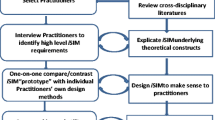Abstract
With the accelerating growth of internet users, a rise of globalization, distributed work environments, knowledge-based economies, and collaborative business models, it becomes clear that there is currently a high and growing number of organizations that demand a proper webstrategy. The emergence of web 2.0 technologies has led many internet companies, such as Google, Amazon, Wikipedia, and Facebook, to successfully adjust their webstrategy by adopting web 2.0 concepts to sustain their competitive advantage and reach their objectives. This has raised an interest for more traditional organizations to benefit from web 2.0 concepts in order to enhance their competitive advantage. This article discusses the effective webstrategy formulation based on the web 2.0 concepts in [21] and the differing requirements, characteristics, and objectives in different types of organizations. This research categorizes organizations into Customer Intimacy, Operational Excellence, and Product Leadership, according to the Value Disciplines model in [26].
Access this chapter
Tax calculation will be finalised at checkout
Purchases are for personal use only
Preview
Unable to display preview. Download preview PDF.
Similar content being viewed by others
References
Batenburg, R., Rutten, R.: Managing Innovation in Regional Supply Networks: a Dutch Case of Knowledge Industry Clustering. Supply Chain Management: An International Journal 8(3), 263–270 (2003)
Benkler, Y.: The Wealth of Networks: how social production transforms markets and freedom. Yale University Press (2006)
Bouman, W., Hoogenboom, T., Jansen, R., Kloos, M.: Sociality and Learning in Social Software. International Journal of Knowledge and Learning 3(4/5), 501–514 (2007)
Breslin, J.G., Decker, S., O’Marchu, I.: Online Social and Business Networking Communities. DERI – Digital Enterprise Research Institute - Technical Report (2004), http://www.deri.at/fileadmin/documents/DERI-TR-2004-08-11.pdf
Brown, B., Harper, R., O’Hara, K., Perry, M., Sellen, A.: Dealing with Mobility: Understanding access anytime, anywhere. ACM Transactions on Computer-Human Interaction 8(4), 323–347 (2001)
Chatti, M.A., Frosch-Wilke, D., Jarke, M.: The Future of E-learning: a shift to knowledge networking and social software. International Journal of Knowledge and Learning 3(4/5), 404–420 (2007)
Chesbrough, H.: Open Business Models: How to Thrive in the New Innovation Landscape. Harvard Business School Press (2006)
Daft, R.L.: Organization Theory and Design. Thomson South Western, Mason (2004)
Donaldson, L.: Reflections on knowledge and knowledge-intensive firms. Human Relations 54(7), 955–963 (2001)
Gallois, C., Gardner, J., Jones, E., Watson, B.: Organizational Communication: Challenges for the New Century. Journal of Communication 54(4), 722–750 (2004)
Gilchrist, A.: Can Web 2.0 be Used Effectively Inside Organisations? Bilgi Dünyası 8(1), 123–139 (2007)
Haggie, K., Kingston, J.: Choosing Your Knowledge Management Strategy. Journal of Knowledge Management Practice 4 (2003), http://www.tlainc.com/articl51.htm
Hoegg, R., Martignoni, R., Meckel, M., Stanoevska-Slabeva, K.: Overview of business models for Web 2.0 communities. In: Dresden, S. (ed.) Proceedings of GeNeMe 2006, pp. 23–37 (2006)
Internet World Stats: Usage and Population Statistics (2007), http://www.internetworldstats.com
Jashapara, A.: Knowledge Management: An Integrated Approach. Pearson Education Limited, Essex (2004)
Kakihara, M., Sorenson, C.: Mobility: an extended perspective. In: Proceedings of the 35th Annual Hawaii International Conference on System Sciences, Hawaii, pp. 1756–1766 (2002)
Kolbitsch, J., Maurer, H.: The Transformation of the Web: How Emerging Communities Shape the Information We Consume. Journal of Universal Computer Science 12(2), 187–213 (2006)
Manafy, M.: The Collective Wisdom at Work. Econtent 29(7), 6 (2006)
Nurmi, R.: Knowledge-Intensive Firms. Business Horizons, 26–32 (1998)
Ohmae, K.: The Mind of the Strategist: Business Planning for Competitive Advantage. Penguin (1982)
O’Reilly, T.: What is Web 2.0: Design Patterns and Business Models for the Next Generation of Software (2005), http://www.oreillynet.com/pub/a/oreilly/tim/news/2005/09/30/what-is-web-20.html
Porter, M.E.: Competitive Strategy: Techniques for Analyzing Industries and Competitors. Free Press (1980)
Scheper, W.J.: Business IT Alignment: solution for the productivity paradox (In Dutch). Deloitte & Touche, Netherlands (2002)
Sigala, M.: Integrating Web 2.0 in e-learning environments: a socio-technical approach. International Journal of Knowledge and Learning 3(6), 628–648 (2007)
Tapscott, D., Williams, A.D.: Wikinomics: How Mass Collaboration Changed Everything. Portfolio Hardcover (2006)
Treacy, M., Wiersema, F.: Customer Intimacy and Other Value Disciplines. Harvard Business Review (1993)
Treacy, M., Wiersema, F.: How Market Leaders Keep Their Edge. Fortune 131(2), 88–93 (1995)
Wikipedia: Strategy (2008), http://en.wikipedia.org/wiki/Strategy
Author information
Authors and Affiliations
Editor information
Rights and permissions
Copyright information
© 2008 Springer-Verlag Berlin Heidelberg
About this paper
Cite this paper
Wijaya, S., Spruit, M.R., Scheper, W.J. (2008). Webstrategy Formulation: Benefiting from Web 2.0 Concepts to Deliver Business Values. In: Lytras, M.D., Carroll, J.M., Damiani, E., Tennyson, R.D. (eds) Emerging Technologies and Information Systems for the Knowledge Society. WSKS 2008. Lecture Notes in Computer Science(), vol 5288. Springer, Berlin, Heidelberg. https://doi.org/10.1007/978-3-540-87781-3_41
Download citation
DOI: https://doi.org/10.1007/978-3-540-87781-3_41
Publisher Name: Springer, Berlin, Heidelberg
Print ISBN: 978-3-540-87780-6
Online ISBN: 978-3-540-87781-3
eBook Packages: Computer ScienceComputer Science (R0)




